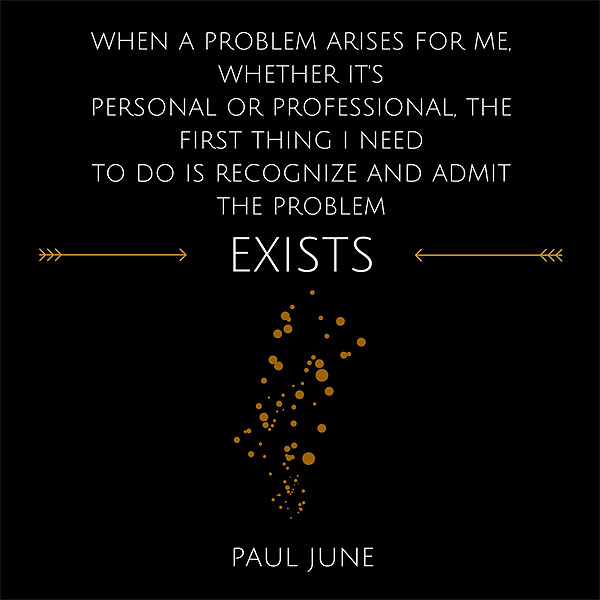Former Secretary of State Madeleine Albright’s recent comment, “To put it mildly, the world is a mess,” pretty much sums up the news these days. Seems like every potential hotspot, from the Middle East, to the Ukraine, to western US wildfires, are heating up . . . or worse.
This got me to thinking about how we react to problems when they arise. Some try to avoid them, some try to explain them away, and others tackle them head on.
I wrote a blog about problem solving a couple of years ago. While its focus was on problem solving of a much more personal, professional, and limited nature than world affairs, I think there the article still contains some sage advice, especially step 1, which is to be willing and able to recognize and admit a problem exists. Only then can we evaluate and diagnose what to do, before we set out to take corrective action.
Here is that blog again. May it help you solve a problem or two in your own corner of the world! Enjoy.

Problem Solving 101
(Originally posted on August 2, 2012)
Encountering a problem is not always the end of the world. Sure, it’s likely we’ll all encounter a catastrophic situation at some point in our lives, but by and large, our day-to-day business and personal problems can be managed and overcome. It’s how we react to these challenges that quite often determines success or failure.
What do you think the outcome would have been for our Apollo 13 astronauts had they failed to respond adequately when an oxygen tank exploded on their way to the moon back in 1970? While they had to abort the lunar landing, the entire crew returned safely to Earth. With some quick thinking and a planful approach to diagnosing the problem and their ways to overcome it, “Houston, we’ve had a problem” turned into “Houston, we’ve solved our problem” and a happy ending.
- When a problem arises in your life, how do you react? When a relationship hits rough water, what do you do—shutdown and retreat, or do you thoughtfully look at the issues and attempt to fix them?
- What about your business? If profits are down, do you just keep on doing the same thing, hoping the problem fixes itself, or do you diagnose what’s going wrong and put together a plan to fix it?
A lot of times I think we avoid our problems because it just seems easier to ignore them, hoping they’ll go away, and also because we fear failure. After all, if we attempt to fix a problem and it doesn’t work out—Ouch!—nothing hurts more. But choosing NOT to address a problem, in my book, is no different than failing to solve it. The problem persists, weighing you down, sapping your energy and enthusiasm. Addressing a problem, even if you fail, does at least one thing—it allows you to let go and move on.
- When a problem arises for me, whether it’s personal or professional, the first thing I need to do is recognize and admit the problem exists (and that’s not always easy for this King Monkey to do!). The last thing any of us wants to do in either a relationship or with our businesses is admit there’s a problem. We all like to think we live “problem free” lives!
- Once I’ve accepted there’s a problem, the next thing I do is evaluate and diagnose it. Just what is the nature of this problem? Is it a people/personnel issue, a product/service issue, a process issue, or is it some or all of these factors combined? (I tend to believe all problems can be looked at through the lens of each of these three factors.)
For example, a relationship issue might be simply that two people just aren’t right for each other (a personal issue) or it might be a “Mars vs. Venus” situation where what’s needed is a basic understanding that we all communicate a little differently (a process issue).
Similarly, if your marketing attempts are falling to connect with your audience, maybe it’s simply a matter of you and your team (personal/personnel) needing to understand the relationship of your customers and your product better (a product/service issue) and retooling your message (a process issue).
“Chimpanzee Problem Solving through Cooperation”
- Now comes the fun part—developing a treatment plan for how I’m going to solve or lessen the problem. This step is fun because I get to exercise my creative thinking muscles, but it’s also challenging. Just because you’ve diagnosed a problem doesn’t mean your action plan to fix it will be as successful as you want or need it to be (just look at our nation’s capital for an example of that). Life isn’t like a TV show where some hero is going to rush in and save the day. Further, there isn’t always a solution to every problem. Some things can’t be solved—at least not always to our satisfaction. But every problem can be addressed. Every problem can be identified, evaluated, diagnosed, and attempts made to solve it.
When we problem-solve, we might not always get exactly what we want or need, but how we react to problems—that we actually react, rather than simply avoiding them, hoping they go away—can teach us a lot about ourselves, what’s important, and how we respond under pressure.
What problems have you had to solve recently? What problems—personal or business-related—need your attention right now?
As a starter, try stepping back and evaluating your situation objectively. Then try one or two things—small things, big things, you be the judge—that move you and the situation forward. Feel that? That’s the burden you’ve been carrying lifting off your shoulders. Feels good, doesn’t it?
Share your problem-solving successes and “lessons learned” here.
